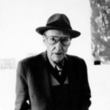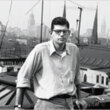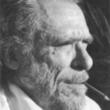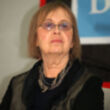On the Road
(Libby/OverDrive eBook, Kindle)
Available Platforms
Description
More Details
Excerpt
Similar Titles From NoveList
Similar Authors From NoveList
Published Reviews
Booklist Review
With writers such as poet Allen Ginsberg, Kerouac founded the Beat movement, and this novel, about a group of the aimless and alienated wandering across the U.S., speaks for ``the Beat generation.'' [BKL S 1 57]
Publisher's Weekly Review
Fans of Kerouac get the whole beautiful, groovy deal with this new recording of the radically hip novel that many consider the heart of the Beat movement. Poetic, open and raw, Kerouac's prose lays out a cross-country adventure as experienced by Sal Paradise, an autobiographical character. A writer holed up in a room at his aunt's house, Paradise gets inspired by Dean Moriarty (a character based on Kerouac's friend Neal Cassady) to hit the road and see America. From the moment he gets on the seven train out of New York City, he takes the reader through the highs and lows of hitchhiking, bonding with fellow explorers and opting for beer before food. First published in 1957, Kerouac's perennially hot story continues to express the restless energy and desire for freedom that makes people rush out to see the world. The tale is only improved by Dillon's well-paced, articulate reading as he voices the flow of images and graveled reality of Paradise's search for the edge. (c) Copyright PWxyz, LLC. All rights reserved All rights reserved.
Library Journal Review
Who hasn't wished to be ``on the road,'' free from daily responsibilities, crossing vast geographical distances, preoccupied largely with sex, music, alcohol, and conversation with friends? Kerouac carved a place in American literature by capturing that common longing with his characters Sal and Dean and their intermittent, rambling trips throughout the Western United States and Mexico. On the Road is an excellent choice for the audio format, since Kerouac's use of language seems even richer when the words are spoken aloud. Narrator David Carridine's nonchalant manner is a perfect match to the work's tone. A necessary addition to most collections. Be aware, however, that this is a reissue of a 1986 recording.-- Jeanne P. Leader, Western Nebraska Community Coll. Lib., Scottsbluff (c) Copyright 2010. Library Journals LLC, a wholly owned subsidiary of Media Source, Inc. No redistribution permitted.
Booklist Reviews
The mythology surrounding On the Road begins with a tantalizing creation story: in a 20-day marathon in April 1951, Kerouac speed-typed the single-spaced manuscript on long sheets of tracing paper he taped together to form a 120-foot scroll. Truly a remarkable feat, although Kerouac, who was not exactly the wild man his image as king of the Beats suggests, had already spent years working on what ultimately became On the Road. The legendary scroll, purchased by Jim Irsay, owner of the Indianapolis Colts, for $2.43 million, is currently being exhibited across the country. To celebrate the novel's fiftieth anniversary, the scroll has finally been fully transcribed and thoroughly explicated in four superb introductory essays. Given that the manuscript diverges from the book in the very first sentence, and that Kerouac used the real names of the friends who inspired his characters and wrote unused sexually explicit passages, this is an intriguing read to say the least. Copyright 2007 Booklist Reviews.
Library Journal Reviews
Though On The Road wouldn't be published until 1957, Keroauc wrote the book's initial draft in 1951 on a 120'-long sheet of paper without any paragraph breaks—a rolling boil of text. The early draft also uses the real names of those upon whom the characters are based (Neal Cassady, Allen Ginsberg, etc.). The story went through several additional drafts, picking up fictitious names (Kerouac became Sal Paradise; Cassady, Dean Moriarty) and toning down the style a bit. The scroll looms large in the Kerouac legend, and this is the first time the original draft has been published as is (still no paragraph breaks). Solid fodder for scholars and a real treat for fans. A big thumbs up (get it?).
[Page 132]. Copyright 2007 Reed Business Information.PW Annex Reviews
In introducing the fabled first draft of Kerouac's autobiographical novel-written on a single giant roll of paper, without breaks in the text, in an amphetamine-fueled marathon-editor Howard Cunnell refers to Allen Ginsberg's claim that "the published novel is not at all like the wild book Kerouac typed in ‘51." Characters are identified by their real names (rather than the 1957 version's apt pseudonyms) and their love affairs are more explicit, giving the book a juicy memoir-like feel, especially where Cassady and Ginsberg are concerned. The plot, however, is identical. Neal Cassady joins Kerouac and Ginsberg's bohemian circle in New York in the late 1940's, and inspires and cons them into traveling around the country, "searching for a lost inheritance, for fathers, for family, for home, even for America." The death of Kerouac's father plays a larger role in the story than in the 1957 version; and Justin W. Brierly, a teacher who served as mentor to Cassady and has a cameo in the published book, makes a series of recurring appearances in the scroll. The lack of paragraphs or chapters emphasizes the breathless intensity of Kerouac's prose. The anniversary publicity will introduce this classic to a new generation of readers, and while the scroll probably won't displace the novel's more familiar, polished incarnation, it will be of keen interest to beat aficionados and scholars. (Sept.)
Reviews from GoodReads
Citations
Kerouac, J. (1976). On the Road . Penguin Publishing Group.
Chicago / Turabian - Author Date Citation, 17th Edition (style guide)Kerouac, Jack. 1976. On the Road. Penguin Publishing Group.
Chicago / Turabian - Humanities (Notes and Bibliography) Citation, 17th Edition (style guide)Kerouac, Jack. On the Road Penguin Publishing Group, 1976.
Harvard Citation (style guide)Kerouac, J. (1976). On the road. Penguin Publishing Group.
MLA Citation, 9th Edition (style guide)Kerouac, Jack. On the Road Penguin Publishing Group, 1976.
Copy Details
| Collection | Owned | Available | Number of Holds |
|---|---|---|---|
| Libby | 2 | 0 | 3 |



































